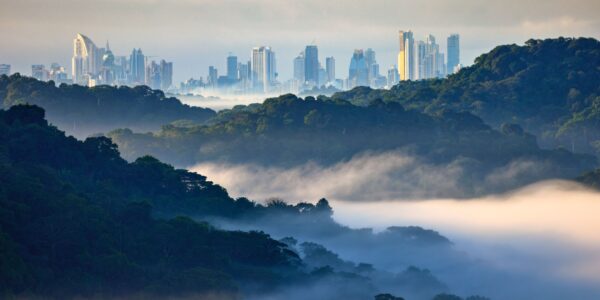

In our battle against climate change, there are few tools as potent and promising as afforestation; the practice of planting trees to absorb carbon dioxide from the atmosphere. Trees act as nature's carbon sponges, sequestering carbon and helping to mitigate the global warming effect. But where should such projects be situated for maximum impact and effectiveness?
One of our forestry projects, Afforestation Project, Panama, spanning 13,242 hectares of land, is not just any project. It's a strategic project that leverages the unique attributes of Panama for maximum ecological and social impact. In a world where the climate crisis demands swift and scalable solutions, our choice of location is paramount.
The ideal climate and growing conditions in Panama
We have carefully selected the Panama project, which focuses on key regions including Darien, Veraguas, Chiriqui, and Bocas del Toro. One of the key reasons behind this strategic choice lies in the optimal climate conditions Panama offers for tree growth. In this article, we explore why these specific regions benefit from Panama's unique climate attributes.
1. Equatorial proximity
Panama's geographical location, spread across the narrow surface connecting North and South America, places it near the equator. This equatorial proximity results in a tropical climate characterized by consistent temperatures throughout the year. Unlike regions with distinct seasons, Panama's climate ensures that temperatures remain warm and suitable for tree growth year-round. Therefore, Panama is a strategic location, guaranteeing a tropical climate for all regions of our projects, including Darien, Veraguas, Chiriquí and Bocas del Toro. What sets these regions apart is the subtle variations in their microclimates. Each offers a unique set of conditions that cater to diverse tree species and afforestation strategies.
2. Year-round warmth
Across these regions, Panama experiences a climate of perpetual warmth. Daytime temperatures typically range from 75°F to 95°F (24°C to 35°C). This continuous warmth provides trees with the optimal temperature range for photosynthesis, allowing them to absorb sunlight and convert it into energy efficiently. Trees in Panama don't have to endure the harsh winters that limit growth in temperate regions, enabling them to grow vigorously.
3. Consistent rainfall
Panama's climate is characterized by two primary seasons: the wet season, which occurs from May to December, and the dry season, spanning from January to April. During the wet season, Panama is drenched with generous rainfall, often exceeding 70 inches (1,800 mm) and even surpassing 100 inches (2,500 mm) annually in specific regions. This consistent and copious rainfall serves as a vital resource for tree growth by ensuring an abundant water supply. It is a key factor in facilitating the development of healthy and robust forests.
These distinct wet and dry seasons have a profound influence on tree growth across different regions of Panama. In Darien, for instance, there is a substantial share of rainfall, especially during the wet season. Veraguas, centrally located, benefits from a more balanced distribution of rainfall throughout the year. In contrast, Chiriqui and Bocas del Toro, situated in the western and northwestern parts of Panama, experiences steady and ample precipitation patterns year-round. These diverse rainfall patterns play a pivotal role in providing the necessary moisture for tree growth, contributing to the establishment of thriving and lush forests in these regions.
4. Ideal microclimates
Panama's rich topography and geographic diversity give rise to a tapestry of microclimates across the country, offering tailored environments for a wide array of tree species. These microclimates, ranging from lowlands to highlands, coastal areas to mountainous terrains, accommodate trees adapted to specific ecological niches. This diversity fosters the coexistence of both tropical and subtropical tree species throughout Panama, making it an ideal and versatile location for diverse afforestation endeavors.
In particular, Panama's varying topography, encompassing lowlands, highlands, coastal expanses, and mountainous landscapes, creates specialized microclimates that cater to specific tree species' needs. In Darien's coastal plains and forests, a unique habitat thrives, providing a haven for various tree species. Veraguas, with its diverse elevations, boasts a harmonious blend of temperate and tropical species. Meanwhile, Chiriqui and Bocas del Toro, characterized by elevation variability, both nurture an ecosystem where temperate and tropical tree species coexist, resulting in a resilient and flourishing forest ecosystem.
5. Volcanic soil enrichment
Panama's volcanic legacy has endowed its soils with valuable riches. Over time, volcanic ash and minerals have imbued these soils with essential nutrients crucial for robust tree growth. These nutrient-rich soils serve as a precious asset for our afforestation project, guaranteeing that the trees have unfettered access to the nourishment they require to flourish. In regions like Chiriqui and Veraguas, this geological heritage continues to enrich the soil with volcanic minerals, ensuring the success of our afforestation endeavors.
6. Elevation variability
Panama's varying elevations further enhance its suitability for tree growth. The Chiriquí Highlands, for example, offer cooler conditions at higher elevations, which can accommodate a broader range of tree species, including those with temperate preferences. This elevation variability allows for a more diverse and resilient forest ecosystem.
In conclusion, Panama's diverse climates, and our projects in Darien, Veraguas, Chiriqui, and Bocas del Toro, offer the perfect environment for our afforestation initiatives. Due to its equatorial proximity, year-round warmth, consistent rainfall, ideal microclimates, volcanic soil enrichment, and elevation variability, Panama offers the ideal combination of factors to create an environment where trees can grow vigorously and efficiently sequester carbon dioxide. Our choice of these locations reflects our commitment to harnessing the power of Panama's climate diversity to combat climate change, conserve biodiversity, and pave the way for a greener, more sustainable future.


More news

Why Reforestation in Uruguay?
Discover how Cuchilla Grande's mild temperatures and ample rainfall create the perfect setting for trees to flourish and sequester carbon year-round.

Embracing Sustainable Transportation in the Moving Industry
Explore the eco-friendly revolution shaping global mobility in the moving industry. From electric vehicles to green logistics, we're reducing carbon footprints and embracing a responsible future.